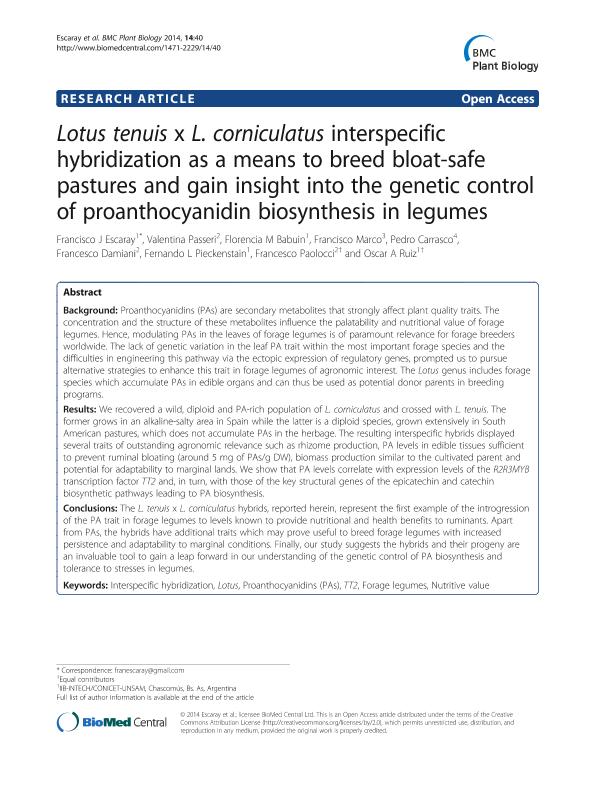Mostrar el registro sencillo del ítem
dc.contributor.author
Escaray, Francisco José

dc.contributor.author
Passeri, Valentina
dc.contributor.author
Babuin, María Florencia

dc.contributor.author
Marco, Francisco
dc.contributor.author
Carrasco, Pedro
dc.contributor.author
Damiani, Francesco
dc.contributor.author
Pieckenstain, Fernando Luis

dc.contributor.author
Paolocci, Francesco

dc.contributor.author
Ruiz, Oscar Adolfo

dc.date.available
2019-07-29T23:02:20Z
dc.date.issued
2014-02
dc.identifier.citation
Escaray, Francisco José; Passeri, Valentina; Babuin, María Florencia; Marco, Francisco; Carrasco, Pedro; et al.; Lotus tenuis x L. corniculatus interspecific hybridization as a means to breed bloat-safe pastures and gain insight into the genetic control of proanthocyanidin biosynthesis in legumes; BioMed Central; BMC Plant Biology; 14; 1; 2-2014; 40-58
dc.identifier.issn
1471-2229
dc.identifier.uri
http://hdl.handle.net/11336/80545
dc.description.abstract
Background: Proanthocyanidins (PAs) are secondary metabolites that strongly affect plant quality traits. The concentration and the structure of these metabolites influence the palatability and nutritional value of forage legumes. Hence, modulating PAs in the leaves of forage legumes is of paramount relevance for forage breeders worldwide. The lack of genetic variation in the leaf PA trait within the most important forage species and the difficulties in engineering this pathway via the ectopic expression of regulatory genes, prompted us to pursue alternative strategies to enhance this trait in forage legumes of agronomic interest. The Lotus genus includes forage species which accumulate PAs in edible organs and can thus be used as potential donor parents in breeding programs. Results: We recovered a wild, diploid and PA-rich population of L. corniculatus and crossed with L. tenuis. The former grows in an alkaline-salty area in Spain while the latter is a diploid species, grown extensively in South American pastures, which does not accumulate PAs in the herbage. The resulting interspecific hybrids displayed several traits of outstanding agronomic relevance such as rhizome production, PA levels in edible tissues sufficient to prevent ruminal bloating (around 5 mg of PAs/g DW), biomass production similar to the cultivated parent and potential for adaptability to marginal lands. We show that PA levels correlate with expression levels of the R2R3MYB transcription factor TT2 and, in turn, with those of the key structural genes of the epicatechin and catechin biosynthetic pathways leading to PA biosynthesis. Conclusions: The L. tenuis x L. corniculatus hybrids, reported herein, represent the first example of the introgression of the PA trait in forage legumes to levels known to provide nutritional and health benefits to ruminants. Apart from PAs, the hybrids have additional traits which may prove useful to breed forage legumes with increased persistence and adaptability to marginal conditions. Finally, our study suggests the hybrids and their progeny are an invaluable tool to gain a leap forward in our understanding of the genetic control of PA biosynthesis and tolerance to stresses in legumes.
dc.format
application/pdf
dc.language.iso
eng
dc.publisher
BioMed Central

dc.rights
info:eu-repo/semantics/openAccess
dc.rights.uri
https://creativecommons.org/licenses/by/2.5/ar/
dc.subject
Forage Legumes
dc.subject
Interspecific Hybridization
dc.subject
Lotus
dc.subject
Nutritive Value
dc.subject
Proanthocyanidins (Pas)
dc.subject
Tt2
dc.subject.classification
Bioquímica y Biología Molecular

dc.subject.classification
Ciencias Biológicas

dc.subject.classification
CIENCIAS NATURALES Y EXACTAS

dc.title
Lotus tenuis x L. corniculatus interspecific hybridization as a means to breed bloat-safe pastures and gain insight into the genetic control of proanthocyanidin biosynthesis in legumes
dc.type
info:eu-repo/semantics/article
dc.type
info:ar-repo/semantics/artículo
dc.type
info:eu-repo/semantics/publishedVersion
dc.date.updated
2019-06-14T18:43:13Z
dc.journal.volume
14
dc.journal.number
1
dc.journal.pagination
40-58
dc.journal.pais
Reino Unido

dc.journal.ciudad
Londres
dc.description.fil
Fil: Escaray, Francisco José. Consejo Nacional de Investigaciones Científicas y Técnicas. Centro Científico Tecnológico Conicet - La Plata. Instituto de Investigaciones Biotecnológicas. Instituto de Investigaciones Biotecnológicas "Dr. Raúl Alfonsín" (sede Chascomús). Universidad Nacional de San Martín. Instituto de Investigaciones Biotecnológicas. Instituto de Investigaciones Biotecnológicas "Dr. Raúl Alfonsín" (sede Chascomús); Argentina
dc.description.fil
Fil: Passeri, Valentina. Institute of Biosciences and BioResources; Italia. Consiglio Nazionale delle Ricerche; Italia
dc.description.fil
Fil: Babuin, María Florencia. Consejo Nacional de Investigaciones Científicas y Técnicas. Centro Científico Tecnológico Conicet - La Plata. Instituto de Investigaciones Biotecnológicas. Instituto de Investigaciones Biotecnológicas "Dr. Raúl Alfonsín" (sede Chascomús). Universidad Nacional de San Martín. Instituto de Investigaciones Biotecnológicas. Instituto de Investigaciones Biotecnológicas "Dr. Raúl Alfonsín" (sede Chascomús); Argentina
dc.description.fil
Fil: Marco, Francisco. Universidad de Valencia; España
dc.description.fil
Fil: Carrasco, Pedro. Universidad de Valencia; España
dc.description.fil
Fil: Damiani, Francesco. Consiglio Nazionale delle Ricerche; Italia. Institute of Biosciences and BioResources; Italia
dc.description.fil
Fil: Pieckenstain, Fernando Luis. Consejo Nacional de Investigaciones Científicas y Técnicas. Centro Científico Tecnológico Conicet - La Plata. Instituto de Investigaciones Biotecnológicas. Instituto de Investigaciones Biotecnológicas "Dr. Raúl Alfonsín" (sede Chascomús). Universidad Nacional de San Martín. Instituto de Investigaciones Biotecnológicas. Instituto de Investigaciones Biotecnológicas "Dr. Raúl Alfonsín" (sede Chascomús); Argentina
dc.description.fil
Fil: Paolocci, Francesco. Consiglio Nazionale delle Ricerche; Italia. Institute of Biosciences and BioResources; Italia
dc.description.fil
Fil: Ruiz, Oscar Adolfo. Consejo Nacional de Investigaciones Científicas y Técnicas. Centro Científico Tecnológico Conicet - La Plata. Instituto de Investigaciones Biotecnológicas. Instituto de Investigaciones Biotecnológicas "Dr. Raúl Alfonsín" (sede Chascomús). Universidad Nacional de San Martín. Instituto de Investigaciones Biotecnológicas. Instituto de Investigaciones Biotecnológicas "Dr. Raúl Alfonsín" (sede Chascomús); Argentina
dc.journal.title
BMC Plant Biology

dc.relation.alternativeid
info:eu-repo/semantics/altIdentifier/doi/http://dx.doi.org/10.1186/1471-2229-14-40
dc.relation.alternativeid
info:eu-repo/semantics/altIdentifier/url/https://bmcplantbiol.biomedcentral.com/articles/10.1186/1471-2229-14-40
dc.relation.alternativeid
info:eu-repo/semantics/altIdentifier/url/https://www.ncbi.nlm.nih.gov/pmc/articles/PMC3927264/
Archivos asociados
